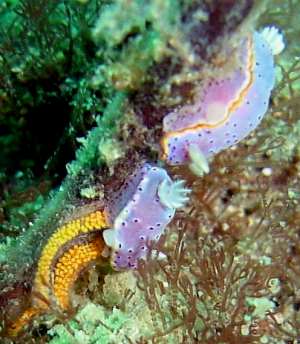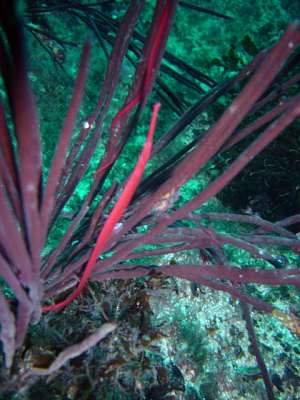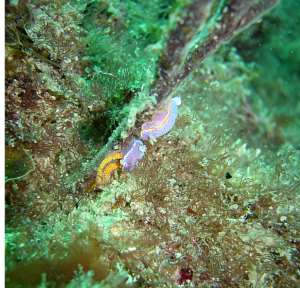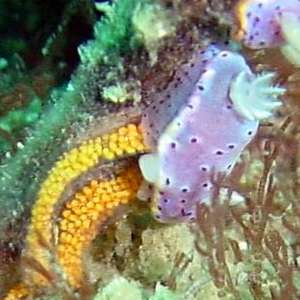Chromodoris woodwardae or C. thompsoni
October 24, 2003
From: Sue Newson

Hi Bill,
During a dive at a site called Boat Harbour Cove in Jervis Bay on Sunday 20 October 2003, I came across these nudibranchs at a depth of 14m. Due to their small size, this is the first successful image I've been able to capture.
I had previously thought they were Chromodoris thompsoni but I believe this image is of C. woodwardae. The colour variations between them has me wondering if its one species or two. I didn't wait around to note any observations other than a photo of the egg laying, due to the true purpose of this particular dive. There was another of these nudibranchs above these two on the same sponge's finger, and a few others on separate finger sponges in the same vicinity. These nudibranchs can be found all over the bay and I have always found them on the same sponge growth that we call, "the red finger sponge". I think this is the one you were referring to in a previous message as 'nondescript'. They are easy to spot as they stand out against the sponge but they are very tiny and any details are usually hard to spot with the naked eye. I've also included a photo of the sponge taken on a previous dive. If you look closely, you can just see one of the nudi's in the center, behind the pipefish.
Sue Newson
snewson@shoal.net.au



Dear Sue,
The egg mass, with large direct developing eggs, and the callyspongiid finger sponge are typical of this species. I will make a note to put more information on the Fact Sheet about this species. C. thompsoni certainly has similarities but usually there are distinct bluish spots or patches as well as reddish spots. In C. woodwardae there are sometimes paler rings around the red spots but never large bluish patches. In C. thompsoni there is usually a broad creamy mantle border with a wavy inner edge, while in C. woodwardae the pale creamy border is relatively narrow and a result of the internal mantle glands. The is usually a gold or yellow band right at the edge. I can't at this time compare the egg masses because we don't know what sort of development C. thompsoni has. We do know that it doesn't eat the finger sponges, Chalinopsilla and Callyspongia sp, which are the choice of C. woodwardae. These two are examples of a group of red-spotted species found in southeastern Australia [see Red spot Page].
Best wishes
Bill Rudman
Related messages
-
Chromodoris woodwardae from Jervis Bay
From: Sue Newson, March 24, 2006 -
Chromodoris woodwardae from SE Australia
From: L. & D. Atkinson, October 21, 2005
